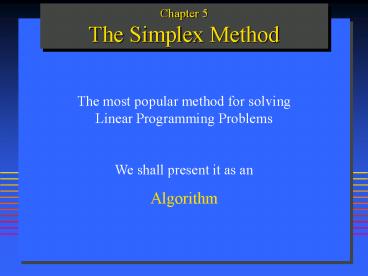Chapter 5 The Simplex Method PowerPoint PPT Presentation
Title: Chapter 5 The Simplex Method
1
Chapter 5The Simplex Method
The most popular method for solving Linear
Programming Problems We shall present it as an
Algorithm
2
General Structure of Algorithms
Initialise
Check for desired results
Yes
Stop
Iterate
No
Perform a sequence of repetitive steps
3
Construct a feasible extreme point
Is this point optimal ?
Yes
Stop
Iterate
No
Move along an edge to a better extreme point
4
Missing Details
- Initialisation
- How do we represent a feasible extreme point
algebraically? - Optimality Test
- How do we determine whether a given extreme point
is optimal? - Iteration
- How do we move a long an edge to a better
adjacent extreme point?
5
5.1 initialisation
- Transform the LP problem given in a standard form
into a canonical form. - This involves the introduction of slack
variables, one for each functional constraint. - Thus if we start with n variables and m
functional constraints, we end up with nm
variables and m functional equality constraints.
6
Standard Form
- optmax
- ???
- bi 0 , for all i.
7
Canonical Form
8
Observation
- The i-th slack variable measure the distance of
the point x(x1,...,xn) from the hyperplane
defining the i-th constraint (This is not a
Euclidean distance). - Thus, if the i-th slack variable is equal to zero
the point x (x1,...,xn) is on the i-th
hyperplane. Otherwise it is not. - The original variables measure the distance to
the hyperplanes defining the respective
non-negativity constraints.
9
Example
x3,x4,x5 are slack variables
10
Why do we do this?
- If we use the slack variables as a basis, we
obtain a feasible extreme point !!!
11
5.5.1 Definition
- A basic feasible solution is a basic solution
that satisfies the non-negativity constraint. - Observation
- A basic feasible solution is an extreme point of
the feasible region. - Thus
- Initialisation involves constructing a basic
feasible solution using the slack varaibles.
12
Example
x3,x4,x5 are slack variables
- Initial basic feasible solution x
(0,0,40,30,15), namely - x1 0 x2 0 x3 40 x4 30 x5 15
13
Summary of the Initialisation Step
- Select the slack variables as basic
- Comments
- Simple
- Not necessarily good selection the first basic
feasible solution can be (very) far from the
optimal solution.
PowerShow.com is a leading presentation sharing website. It has millions of presentations already uploaded and available with 1,000s more being uploaded by its users every day. Whatever your area of interest, here you’ll be able to find and view presentations you’ll love and possibly download. And, best of all, it is completely free and easy to use.
You might even have a presentation you’d like to share with others. If so, just upload it to PowerShow.com. We’ll convert it to an HTML5 slideshow that includes all the media types you’ve already added: audio, video, music, pictures, animations and transition effects. Then you can share it with your target audience as well as PowerShow.com’s millions of monthly visitors. And, again, it’s all free.
About the Developers
PowerShow.com is brought to you by CrystalGraphics, the award-winning developer and market-leading publisher of rich-media enhancement products for presentations. Our product offerings include millions of PowerPoint templates, diagrams, animated 3D characters and more.

